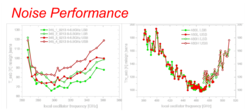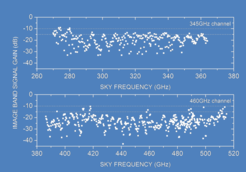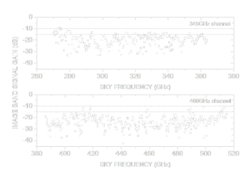Basic Facts
- simultaneous observations in the 870mm and 630mm atmospheric windows, with sky frequency coverage from 262 – 374 GHz and 374 – 516 GHz
- single sideband separating SIS mixers with state-of-the-art sensitivities
- 4 – 8 GHz IF bandwidth in each sideband [4x4 = 16 GHz total bandwidth], connected to our
- latest generations of digital spectrometers (spectral resolutions of 38 kHz and 76 kHz resp.)
- excellent stability, with spectroscopic Allan Variance times of several 100 seconds
- fast automatic change of frequencies, with fully remote operation
|
Channel |
Sky Frequencies |
Op. Modes |
IF-Bandwidth |
Spectral Resolution |
Trx(SSB) |
|
345 GHz |
262-374 GHz |
2SSB |
2 x 4-8 GHz |
38 kHz |
70-120 K |
|
460 GHz |
374-516 GHz |
2SSB |
2 x 4-8 GHz |
76 kHz |
100-180 K |
|
Relative pointing between the two channels: < 0.5 arcsec |
|||||
Receiver Noise Temperatures
System noise temperatures are absolutely state-of-the-art (see T. Klein et al. for details). To calculate noise temperatures including atmospheric losses, use the APEX time estimator.


Sideband Separation
Sideband separation is excellent: for more than 90% of the frequency bands the image band signals are suppressed by more than 15 dB. As of Sept 01 2013, the APEX online calibration does assume by default 15 dB suppression for both FLASH channels (check the CLASS headers for the actually applied separation). Because the separation is frequency dependent, for best results the offline calibrator shall be used with the separation applicable to a given tuning.


Receiver Stability
The stability of the receiver, as measured in the telescope environment, is excellent: spectroscopic Allan-minimum times of more than 200s with 1 MHz channel equivalent noise bandwidth (ENBW) allow for efficient on-the-fly observations and the detection of weak broad (e.g., extragalactic) lines.



